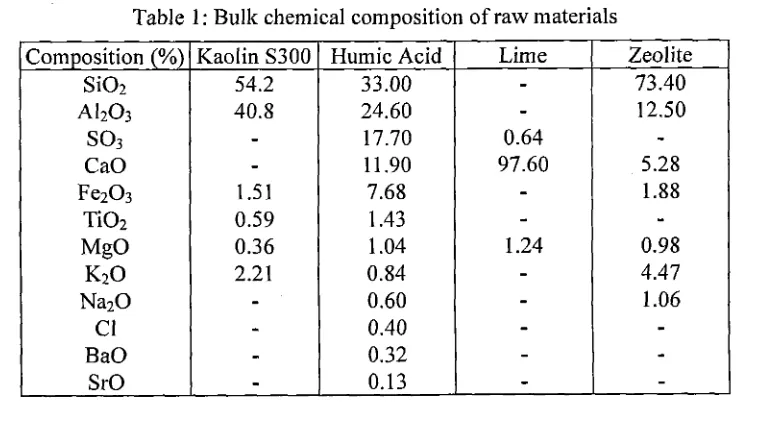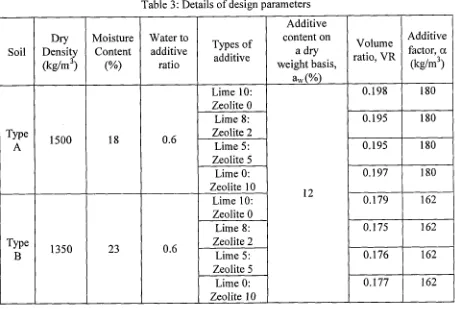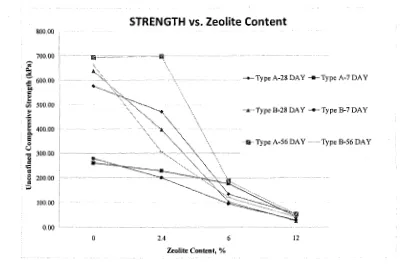Stabilization of Artificial Organic Soil at Room Temperature using
Blended Lime Zeolite
Felix N. L. ~ i n g ' .
21a,Khairul Anuar Kassim21b,
Ahmad Tarmizi Abdul Karirnlvc
and Tze
Wei
chan2
1
Faculty of Civil & Env. Eng., Universiti Tun Hussein Onn Malaysia (UTHM), Malaysia
2
Faculty of Civil Eng., Universiti Teknologi Malaysia (UTM), Malaysia
afelix@uthm.edu.my, bkanuar@utm.my, ctarmizi@uthm.edu.my
Keywords: Organic soil, Lime, Zeolite, Kaolin, Humic Acid
Abstract. Organic content in soil is believed to inhibit formation of reaction products in lime stabilization which resulted in low gain of strength when dealing with organic soils. Zeolite, a kind of pozzolan with high CEC capacity is proposed to be use in this study in order to improve lime stabilization of organic soil. The effectiveness of blended lime zeolite in stabilization of organic soils was investigated by using two types of artificial organic soils with predetermined organic contents. Artificial organic soils were formed by mixing inorganic soil (commercial kaolin) with organic matter (commercial humic acid) at specific ratio. Initial consumption of lime for organic soils was determined in order to determine the minimum percentage of stabilizer required for each soil. Potential influencing factors that might affect the strength such as organic contents, contents of stabilizer, and curing periods were studied. The findings of the study showed that high organic contents and low lime contents resulted in lower gain of strength. However, it is found that slight replacement of lime with zeolite works well with low organic soil at long curing period which resulted in highest strength among all the mixes. Overall, longer curing periods will increase the
strength of the soil in the order of 56 days > 28 days > 7 days. Nevertheless, the percentage of strength
increment over curing periods is linear with the lime contents, which proved that lime is required for pozzolanic reaction.
Introduction
Chemical stabilization of soft soils by admixing it with stabilizers such as lime and cement are means to increase strength, reduce deformability, provide volume stability (control shrinkage and swelling), reduce permeability, reduce erodibility, increase durability, or control variability of natural soils [I]. However, most often high organic content in the soil reduces the effectiveness of lime or cement stabilization [2]. Previous study also found that the soils with high organic contents normally experienced lower strength increment after stabilization, if compared with inorganic soils that stabilized with the same types and amounts of stabilizer [3].
Natural zeolite is a type of aluminosilicate mineral containing large quantities of reactive SiOz and AI2o3. It had been identified as one of the most promising natural high quality pozzolans [4] and widely used in cement industry in China as a cement blending material. Zeolite is also used as a mineral admixture to produce high performance concrete in China. It is generally considered that zeolite contributes to concrete strength mainly through the pozzolanic reaction with Ca(OH)2, like
other pozzolanic materials such as silica fume and fly ash [ 5 ] . The reactivity of the natural zeolite as
pozzolans is influenced by its grain sizes, in which the finer of the material shows higher short term pozzolanic activity. However, the influence can be less significant after 1 day [6].
In this study, the stabilizer- lime was partially replaced with zeolite in order to form blended lime zeolite. The effectiveness of blended lime zeolite were studied by mixing the stabilizer with artificial organic soils and cured at room temperature for various curing periods. The unconfined compressive strength was utilized as a guide of the effectiveness of stabilizer.
All r ~ g h t s resewed. No part of contents of this paper may www.ttp.net. (ID: 110.1 59.87.236-26/05/13.05.01:43)
986 Innovation and Sustainable Technology in Road and Airfield Pavement
Materials and Experimental Programme
Materials. The artificial organic soils identified as Type A and Type B organic soil were formed by
blending inorganic soil (commercial kaolin grade S300) with organic matter (commercial humic acid)
at predetermined ratio. Kaolin grade S300 produced by Kaolin (M) Sdn. Bhd. was reported to be
dominant silt sized with greater than 90% of the material passing sieve 63 micron [7]. Its bulk density falls into the range of 0.7-0.9 glcc and its moisture content was less than 2% [8]. Whereas, the humic acid utilized in this study was commercial graded humic acid which was obtained from a local fertilizer shop. The humic acid was reported to be highly organic with Loss on ignition at 440°C around 60% and total organic carbon versus total carbon as high as 99% [9]. The ratio of Type A and
Type
B
artificial organic soils were 70% Kaolin vs. 30% Humic Acid and 50% Kaolin vs. 50% humicacid, with its loss on ignition at 440°C were determined as 18% and 29%, respectively. Based on the Extended Malaysian Soil Classification System [lo], the type A soil was categorized as slightly organic soil while the type B soil was organic soil with organic content greater than 20%.
The stabilizers were prepared by partial replacement portion of lime (hydrated lime) with natural zeolite. Four types of stabilizer were utilized in this study, namely Lime 10: Zeolite 0, Lime 8: Zeolite 2, Lime 5: Zeolite 5 and Lime 0: Zeolite 10, in which its name indicated the proportions of lime and zeolite of the stabilizer. The hydrated lime utilized in this study was locally manufactured by Lime
Treat (M) Sdn. Bhd., while the natural zeolite was imported from Indonesia and was crushed &
grounded, and samples passing 150 micron's sieve was used. All the raw materials were air dried and stored in air tight container before use. The bulk chemical compositions of the raw materials were
analyzed by X-ray fluorescence (XRF) and are shown in Table 1. Besides it, the pH of the materials
[image:2.611.117.496.422.633.2]were also tested and tabulated in Table 2.
Table 1 : Bulk chemical composition of raw materials
Table 2: pH of the raw materials and its reference standard Zeolite 73.40 12.50
-
5.28 1.88-
0.98 4.47 1.06-
-
-
Composition (%)
SiO2 A1203
s
0 3CaO Fez03 Ti02 MgO K20 Na20
C I BaO SrO Humic Acid 33.00 24.60 17.70 11.90 7.68 1.43 1.04 0.84 0.60 0.40 0.32 0.13 Kaolin S300 54.2 40.8
-
-
1.51 0.59 0.36 2.21-
-
-
-
Zeolite 10.68 Lime-
-
0.64 97.60-
-
1.24-
-
-
-
-
Lime 12.52 Type B 4.41 5gl100mlBS 1924-2:1990 Clause 5.4.5.3
Type A
4.68 Ratio of water/solid Reference standard Materials
pH (at 2 5 " ~ )
30gl75ml
BS1377-3:1990 Clause 9.5 Kaolin S300
6.82
Humic Acid
Based on the Table 1 and Table 2, the hydrated lime utilized in this study is of high quality with high contents of CaO and high pH when tested for its suitability use. Whereas, the zeolite utilized with high SiIAl ratio were expected to have lower exponential reaction, thus reacted faster [6].
Experimental Programme. A laboratory procedure was planned and carried out to determine the
possibility of using blended lime zeolite in wet method of deep mixing when encountering the organic soil. Knowing that the mixture strength will vary with different mix proportions and ground conditions [l I], the laboratory procedure takes into consideration of two different types of soil with
different organic contents (artificial organic soil Type A and Type B) and four different types of
stabilizer with different proportions of lime zeolite. Nevertheless, a laboratory procedure cannot be expected to replicate all the construction complexity, such as thoroughness of mixing, loading conditions etc. Indeed, laboratory testing is planned as a reference point for making judgements about what can be achieved in the ground for the specified soil and conditions [ l 11. Artificial organic soils, instead of natural organic soils, were chosen in this study with the aim to eliminate the influence from different types of organic matter that may be encounter in the natural organic soils on the strength development of stabilized soils. Besides it, the artificial organic soils were also commonly used in laboratory studies [12, 131 for its excellent repeatability.
The laboratory procedure for determining the effectiveness of partial replacement of lime with zeolite in stabilization of organic soil were carried out with accordance to BS 1924-2: 1990 which was specifically referred to lime stabilization of materials for civil engineering purposes. Minimum percentage of stabilizer required was determined through Initial Consumption of Lime test [14], which in theory referred as the minimum lime required for pozzolanic reaction. In order to simulate the wet method of deep mixing, the water to additive ratio is set as 0.6 [15]. The specimens were
remolded manually and prepared into cylindrical size of 50mm x lOOmm at predetermined density
and moisture content by axial compression [16]. The specimens were cured in a humid container for curing periods of 7 days, 28 days and 56 days before tested for its strength. The specimens were wrapped with cling film to avoid excessive water loss through evaporation. The dimensions and weight of the specimens before and after curing were also determined as the precautionary steps taken t o identify potential swelling or shrinkage of samples throughout the curing periods. Unconfined compressive test (refer to BS 1924-2: 1990, Clause 4.1) was chosen in this study as the test is quick and yet informative in providing information such as stiffness, and failure pattern. Moreover, in
, practice, construction specifications often based acceptance on the unconfined compressive strength
of a mixture [ l 11.
Practically, besides the water to additive factor, the designer also needs to predetermine the volume ratio, VR, necessary to achieve target values of additive factor, a. Hence, it is worthwhile to define terms used to quantify mix proportions as follow:-
WW,Sl"~~
water to additive ratio of the slurry, w : a = - (dimensionless)
Wadditive
Vslutly
volume ratio, VR = - (dimensionless)
'soil
additive factor, cr = L ( k g / m 3 or pcf)
'soil
988 Innovation and Sustainable Technology in Road and Airfield Pavement
Table 3: Details of design parameters
Results and Discussion
In general, Figure 1 shows that the strength of the stabilized material increased with curing periods from 7 days to 56 days. However, it needs to highlight that the percentage of strength increment over curing periods are smaller with increased percentage of zeolite replacement. Hence, it explained why the strength increment over curing periods for samples with Lime 5: Zeolite 5 and Lime 0: Zeolite 10 were not significant. Based on Figure l(g), it is obvious that no pozzolanic reaction takes place without the existence of lime. Hence, the soil is still plastic, with low strength and relatively high strain (greater than 5%) at failure when tested for its unconfined compressive strength. Besides it, also shows that the strength of the materials are governed by its humic acid contents when the same types of stabilizer and similar amounts of stabilizer were utilized. Overall, higher humic acid contents
lowered the strength of the soils, which shows that the strength of soil B is lower than soil A. The
findings is similar with previous study [3], which found that as the organic content increases, the strength decreases when the stabilizer was set as constant. In theory, by nomalizing the additive factor, the strength of soil B can be increased. However, the viablility in terms of economic will need to be taken into consideration when more stabilizer were needed.
Additive factor, a (kg/m3) 180 180 180 180 162 162 162 162
From the other perspective, Figure 2 shows the strength of stabilized artificial organic soils versus percentage of zeolite replacement at room temperature. The specimens with 12% and 0% of zeolite content actually served as the control specimens with no lime added and only lime added, respectively. Overall, it is shown that increment of zeolite replacement had shown significant low strength gain in stabilized organic soils. It is believed that zeolite which has low acid buffering
capacity (by having low alkaline composition such as CaO contents ) were not able to provide a
suitable pH environment for pozzolanic reaction when added in excess. However, it is interestingly found that by having low percentage of zeolite replacement (2.4%) on low organic content types of organic soil (Type A soil) at 56 days of curing had shown highest strength gain even though with the lowest volume ratio of 0.195. Previous studies [6, 171 suggested that the pozzolanic reaction at longer ages can be governed by silica and alumina active contents. Natural zeolite, even though crystalline,
can act as pozzolanic materials because of its active contents [I 8, 191.
Volume ratio, VR 0.198 0.195 0.195 0.197 0.179 0.175 0.176 0.177 Additive content on a d r y weight basis,
a,
(%I
12 Types of additive Lime 10: Zeolite 0 Lime 8: Zeolite 2 Lime 5: Zeolite 5 Lime 0: Zeolite 10
Soil B + L:Z (10:O)
900
-C- 56D-A
-4- 56D-B
h 56D-C
2 XD-A
-* 28D-B
+ 28D-C
-- -- 7D-A -7D B
(a) Soil type A with Lime 10: Zeolite 0
Soil A + L:Z (8:2)
800
Axial Displacememt %
(c) Soil type A with Lime 8: Zeolite 2
Soil A + L:Z (5:5)
250
P* 4
200
150
100
50
0
(b) Soil type B with Lime 10: Zeolite 0
Soil B
+
L:Z (8:2)600
(d) Soil type B with Lime 8: Zeolite 2
Soil B + L:Z (5:5)
160
140
-*- 28D-C
-
7D-AAwls1 Dlsplace~nent %
990 Innovation and Sustainable Technology in Road and Airfield Pavement
Soil A
+
L:Z (0:lO)0 5 10 15 20
-
7 ~ 1 ~ M a 1 Displacement "/. [image:6.615.77.531.58.309.2] [image:6.615.95.506.332.597.2](g) Soil type A with Lime 0: Zeolite 10 (h) Soil type B with Lime 0: Zeolite 10
Figure 1 : Strength versus axial displacement for various mixes
STRENGTH vs. Zeolite Content
4'
?< -+-Type A-28 DAY +Type A-7 DAY
6..
<>
>?\ ...
', '.. ---w -A Type B-28 DAY -*. - Type B-7 DAY
\ \ \
.
\. \, \ \> I Type A-56 DAY
2 4 6
Zeolite Content, '%
B-56 DAY
Figure 2: Strength versus zeolite replacement in lime stabilized organic soils
Conclusions
Acknowledgements
The authors wish to gratefully acknowledge the financial support Erom Ministry of Higher Education (MOHE), Malaysia and Universiti Tun Hussein Onn Malaysia (UTHM) through MDR Vot no. 1 108 and also through the PhD scholarship for first author. The authors also thank Mr. Zulkifly Wahid, and others technician of Geotechnical Lab., UTM for their kind assistance throughout the study.
References
[I]
M.
R. Hausmann, Engineering Principles of Ground Modification, McGraw-Hill PublishingCompany, Singapore, 1990.
[2] S. Koslanant, K. Onitsuka, & T. Negami, Influence of Salt Additive in Li&e Stabilization on
Organic Clay, J. of The Southeast Asian Geotechnical Society. 37 (2006) 95-101.
[3] M. Ruis, & T. Hansson, Stabilization of Organic Soil with The Limix System, in: Proceedings of
The Deep Foundations Institute's Soil Mixing Committee Specialty Seminar: Soil Mixing, New Jersey, 2001, pp. 41-49.
[4] C. Colella, M. de' Gennaro, R. Aiello, Use of zeolitic tuff in the buiding industry, in: D.L. Bish, D.W. Ming (Eds.), Natural Zeolites: Occurrence, Properties, Applications, Reviews in mineralogy and geochemistry, Mineralogical Society of America, Washington, 2001, pp. 55 1-588.
[5] C. S. Poon, L. Lam, S. C. Kou & Z. S. Lin, A Study on the Hydration Rate of Natural Zeolite
Blended Cement Pastes, Construction and Building Materials. 13 (1999) 427
-
432.[6] G. Mertens, R. Snellings, K. Van Balen, B. Bicer-Simsir, P. Verlooy, J. Elsen, Pozzolanic
reactions of common natural zeolites with lime and parameters affecting their reactivity, Cement and Concrete Research. 39 (2009) 233-240
[7] F. N. L. Ling, K. A. Kassim, & A. T. Abdul Karim, Size Distribution Analysis of Kaolin using
Laser Diffraction Technique, Adv. Materials Research 341-342 (201 2) 108-1 12.
[8] Kaolin (M) Sdn. Bhd. Technical data sheet Kaolin S300 (SM-CR-535)
[9] F. N. L. Ling, K. A. Kassim, & A T. Abdul Karim, Molecular Characteristics of Malaysian
Pontian PeatIOrganic Soil, Proceedings of The 3rd International Conference on Mechanical &
Electrical Technology (ICMET 2011), Vol. 2, pp.775-780, Aug 26-27 2011, ASME Press.
http://dx.doi.org/l0.1115/1.85981O.paper252
[lo] P. M. Jarrett, Site Investigation for Organic Soil and Peat. IKRAM, JKR GEOGUIDE 6, JKR
20709-0341-95 (1 995).
[ I l l G. M. Filz, D. K. Hodges, D. E. Weatherby, & W. A. Marr, Standardized Definitions and
Laboratory Procedures for Soil-Cement Specimens Applicable to the Wet Method of Deep Mixing, GSP 136 Innovations in Grouting and Soil Improvement, ASCE (2005).
[12] P. Harris, 0. Harvey, A. Puppala, S. Sebesta, S. R. Chikyala, and S. Saride, Mitigating the Effects
of Organics in Stabilized Soils: Technical Report 0-5540-1 (2009)
[I31 N. Z. Mohd Yunus, D. Wanatowslti, and L. R. Stace, Effect of Humic Acid on Physical and
Engineering Properties of Lime-Treated Organic Clay, Engineering and Technology 59 (2011) 1820-1 825
[14] BS1924-2:1990, Stabilized materials for civil engineering purposes- Part 2: Methods of test forcement-stabilized and lime-stabilized materials
[15] R. N. J. Jameson, Mechanical Properties of Soil Cement and Applications in Excavation Support,
992 Innovation and Sustainable Technology in Road and Airfield Pavement
[16] BS EN13286-53:2004, Unbound and hydraulically bound mixtures: Part 53: Methods for the
manufacture of test specimens of hydraulically bound mixtures using axial compression
. [I71 F.Massazza, Properties and applications of natural pozzolanas, in: J. Bensted, P. Barnes (Eds.),
Structure and Performance of Cements, 2nd edition, Spon Press, London, 2001, pp. 326-352.
[18]
B.
Ahmadi, & M. Shekarchi, Use of natural zeolite as a supplementary cementitiousmaterial.Cement & Concrete Composites 32 (2010) 134-141
[19] B. Uzal, L. Turanli, H. Yiicel, M. C. Gonciioglu & A. Culfaz, Pozzolanic activity of clinoptilolite:
A comparative study with silica fume, fly ash and a non-zeolitic natural pozzolan. Cement &


